
The Complete Guide to Renting as a Student

Renting your first apartment is an exciting time. It may be your first real taste of adulthood — and brings with it fun opportunities like decorating and deciding how you want to stock your fridge. But it also comes with responsibility, like making sure you pay for your rent and utilities on time and keep your place clean. Plus, renting as an undergrad can come with its own challenges like finding a or securing a guarantor.
If you’re renting for the first time as a college student, you may be intimidated — but you’re not alone. According to a study by the Joint Center for Housing Studies of Harvard University, 78% of householders under the age of 25 are renters. Even better, we’re here to help, with our complete guide to renting as a student.
Are you ready to ditch your college dorm room and move out on your own? Read on for everything you need to know. In this guide, we cover the following:
This guide includes excerpts from other guides published on our site. For more information for renters, check out our Renter Guide page.
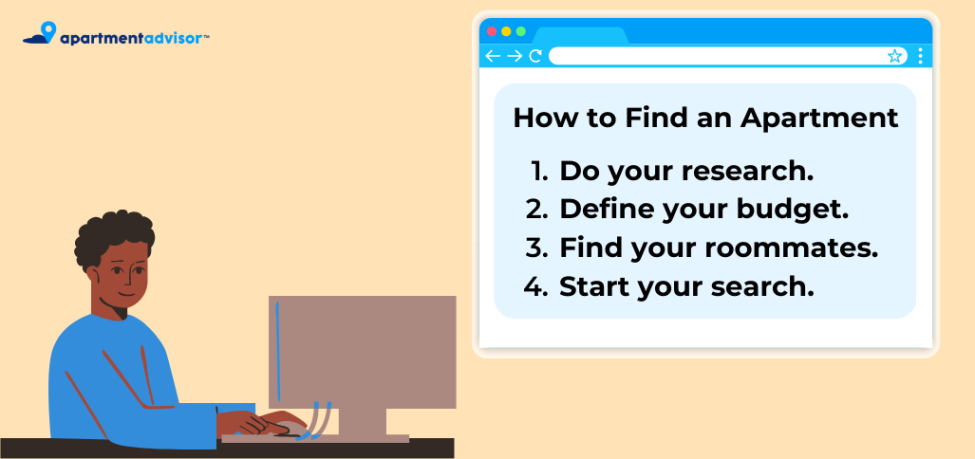
Starting an apartment search can feel overwhelming, even if it isn’t your first time renting. When you’re a student looking for an apartment, you’ll have to keep a few extra factors in mind, like:
- The distance between a potential apartment and your school (and public transportation options)
- Whether or not the apartment accepts student renters
- How much you can afford to pay in rent
As an undergrad, your first step in your apartment search should be speaking with other students who have lived off-campus or, if your college or university has one, with school’s off-campus housing office. Speaking with people who are more experienced in the area’s rental market can help you narrow down your search to the right neighborhood, so you don’t waste your time looking in places that are too far from campus or don’t have a lot of student-friendly housing. We have provided neighborhood guides on a number of major cities with large student populations, like Boston, Austin, Philadelphia, and Washington, DC as well.
Timing will be another factor that varies hugely depending on your rental market. In some cities, like Boston, it’s common to sign a lease in January with a move-in date of September. In others, like New York City, you may be signing a lease only weeks before your move-in date. Find out what the average renting timeline looks like in your college town well in advance so you are left with plenty of options.
Doing your research on the area where your college is located will also help you determine whether you will need to work with a real estate professional during your apartment hunt. In some markets, like in Boston, most renters must work with a broker to rent an apartment (which means paying a broker’s fee, which we will provide more detail on later in the guide.) In others, like Austin or Dallas, many renters work with an apartment locator, who focuses on rentals, instead.
In addition to fellow students and your school housing office, the internet can be a great resource to learn about how your rental market works. Look into housing-specific subforums on Reddit or Facebook groups. There may already be a group on Facebook dedicated to helping students find off-campus housing and roommates for your area.
If you are located in Boston or New York City and want a little extra guidance while renting, ApartmentAdvisor can help. Our Verified Listings program (coming soon to other markets!) gives you access to select properties that we’ve vetted. Plus, if you inquire on a Verified listing, our expert advisors will walk you through the whole renting process — from setting up tours to signing a lease. View Verified Listings in Boston and New York.
Our general rule of thumb for renters is to spend no more than 30% of your monthly income on rent — but this can be a grey area for students who are renting, but not working full-time. Your budget will depend on your financial situation.
Have your parents or guardians allotted a certain amount of funds to go toward your housing? Do you have a housing stipend or scholarship money from your school? Are you using your own income or a loan to pay for your housing?
Figure out how you intend to pay your rent each month, and then determine a budget from there. It may not be reasonable to spend only 30% of, say, a stipend from your school on housing — but let that figure serve as a guide for how you want to organize your budget. Keep in mind that you can’t commit all of your budget to rent, since you’ll also need to factor in the cost of purchasing food and groceries (especially if you do not have a meal plan), utilities, transportation, and other essentials.
It's important to know your budget early on in the process because it will help determine a few areas of your search, like whether you will need to live with roommates (and if so, how many), what neighborhood you will be able to afford to live in, and what type of building. Use your budget to determine exactly what kind of apartment you’re looking for. I
For help determining your ideal rent payment, try our free, quick, and easy-to-use rent calculator, which even allows you to factor in monthly recurring expenses when determining your budget.
Step Three: Find Your Roommates

Once you are armed with information about what neighborhoods and types of buildings you’re interested in, you are just about ready to actually start your apartment search.
If you decide that you want to live with roommates, you’ll need to find and pick them before you start seeing apartments and filling out any applications — as many properties will require you all to apply together simultaneously. (If you’re going to live solo, then go straight to the next step on our list.)
Perhaps you already have someone in mind. If so, great! If not, considering asking around as a friend may know someone else in need of a roommate, or if you don’t mind living with a stranger, try looking at housing groups on Facebook. In either case, just make sure you are compatible first before proceeding.
Before moving in with a roommate, whether a friend or a stranger, it's important to make sure you not only like each other's company, but that you're well-suited to live together. For example, you're in the same stage of life; you're both neat freaks, messy types, or somewhere in between; you keep similar hours; you're both morning people or night owls; you're both dog people or cat people or really not pet people at all.
For more details on finding a roommate and determining compatibility, read our full guide on roommates.
The process of your apartment search will be unique to your rental market, but in most cases, a good apartment hunt starts online.
On ApartmentAdvisor, you can key in specific neighborhoods or cities into our search bar. We give every listing a deal rating to let you know if an apartment is fairly priced for the market. When searching for a place online, make sure to adjust the filters so that you only see apartments with the correct number of bedrooms, the right rent price, and a feasible move-in date. Then comes the fun part! Scroll through the listings and try to picture yourself in your future home. If an apartment is within budget and seems like it is in a nice building and neighborhood, feel free to schedule a walkthrough to get a better sense of the space. Write a list of questions you want to ask about the apartment before you tour to make sure it meets your needs.
If you are in a situation where you need to rent sight unseen — like if you are currently located out-of-state and can’t travel to apartment tours — then you may want to schedule a video or virtual tour and read up on our resources about sight unseen renting.
However, if you are located nearby and a landlord does not want to allow you to do a tour, you may be facing a potential rental scam. Be wary of any listings that seem “to good to be true” or any landlords who are trying to rush you through the process without doing any due diligence. We offer a detailed guide on rental scams and how to avoid them in our Renter Guide.
Craigslist, Facebook groups, and Facebook marketplace are also areas online where you can find apartment listings.
How to Fill Out a Rental Application
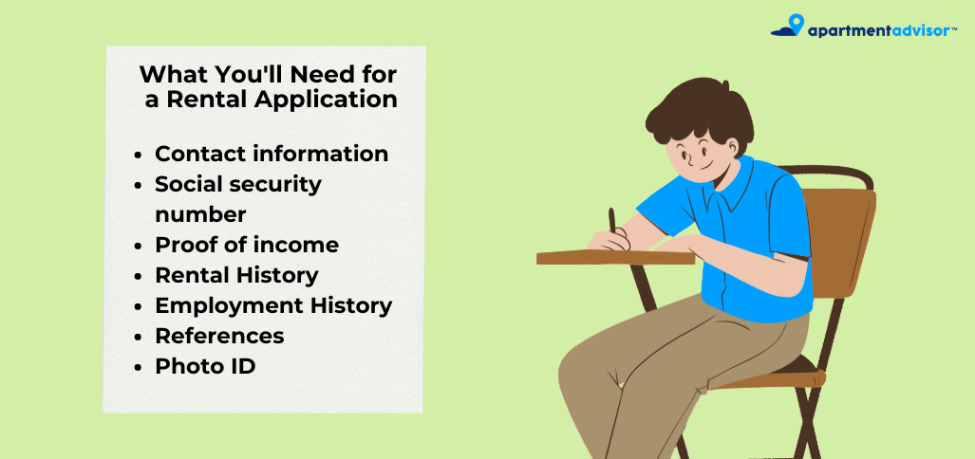
Hopefully, during your apartment search, you’ll find a great place that’s student-friendly, within your budget, close to your college, and just what you were looking for. Then, it’ll be time to start filling out your rental application.
Depending on how competitive the rental market you are looking in is, you may need to start filling out your rental application the same day you toured an apartment. It’s helpful to go into a search knowing what information you’ll need to rent an apartment. Most rental applications will ask prospective tenants for the following:
- Contact information
- Social security number
- Proof of income
- Rental history
- Employment history
- References
- Photo ID
Some applications will also require you to pay a fee, which is perfectly normal in some rental markets and illegal in others, like in Boston. Do an online search on your local laws and know your rights before you pay a fee.
Mostly everything else you’ll need is pretty straightforward, but if you’ve never rented an apartment before, you may be a little confused about what to put under rental history or references. Above all else, be honest in your rental application about your situation.
If a property is student-friendly, you won’t be the first applicant to be a first-time renter. In the space for rental history, you can explain that you are a student who currently lives at home or in a door room.
While former landlords or property managers make the best references, they aren’t the only option. Former and current employers or co-workers can directly speak to your work ethic and verify your income, but can also comment on how you are a responsible, helpful, and kind person at work. Family friends, mentors, and community leaders can make effective references if they know you well and are willing to vouch for your character. For more information, read our guide on references.
If a potential landlord is hesitant about your application or if you are worried about losing out on your dream apartment, you may want to attach a one-page cover letter to your application. While it’s not required, a cover letter can put your application over the edge in a competitive market. If you are already a very strong applicant, use your cover letter as an opportunity to explain why you would be a great fit for this apartment, what you love about the property or neighborhood, and what you will bring to the community as a tenant.
It can be a very powerful personal touch, and can make your application seem more human. Cover letters — or, if you are applying to an apartment digitally, emails — are one of the best ways to make a good first impression on a potential landlord. Read our guide for even more tips on strengthening your rental application.
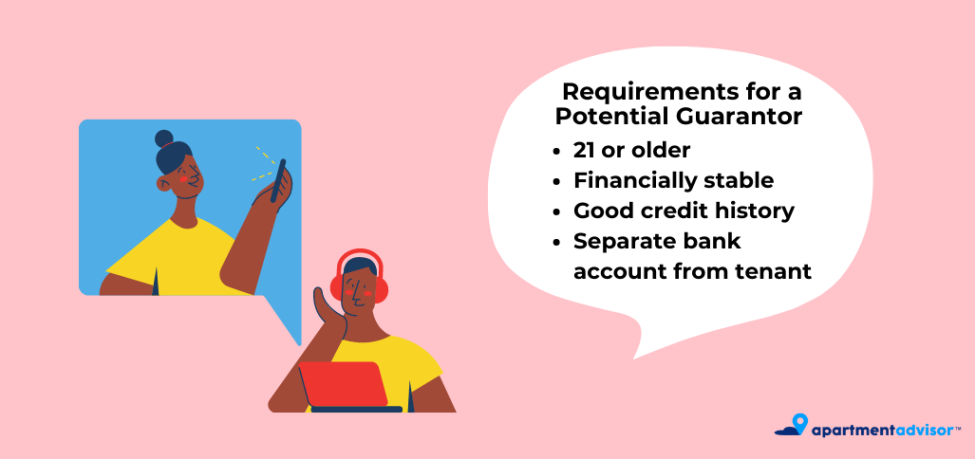
One possibility is that your potential landlord accepts your application, pending the addition of a guarantor or a cosigner on your lease. A guarantor is an individual who signs a lease guaranteeing that they'll cover any rental fees the tenant is unable to pay. They sign the apartment lease along with the tenant, much like a cosigner does for a loan. A cosigner does the same (with the only difference between the two being that a cosigner can legally inhabit the rental unit.) The two terms are often used almost interchangeably.
If and when a renter needs a guarantor depends on several factors, including credit score, credit history, and income, to name just a few. For first-time renters early in their careers, it is not uncommon to need a guarantor for an apartment lease. Young roommates will often need more than one guarantor on a lease, so you and all of your roommates may each need to find someone to sign the lease with you.
Consider asking close friends, family members, or others with whom you have a strong relationship to cosign your lease with you. Just keep in mind, guarantors must meet the following requirements:
- Individuals must have state-issued identification and be at least 21 years or older.
- Guarantors must have good financial stability.
- The guarantor must have a good credit history.
- This individual must have a separate bank account from the tenant.
- They must furnish financial documents, including bank statements, pay stubs, and tax returns.
Once you’ve gotten approved for your new pad, it’s time to sign the lease! This may be one of the first contracts that you’re signing in your life at this point, so make sure you read the fine print before proceeding. A lease agreement is a legally binding contract, and you need to be aware of what you are agreeing to do.
Lease Terms to Know Before Signing
While your lease terms will vary from apartment to apartment — and even more so across different states — there are a few standard terms you can and should look out for before signing your lease.
Confirm that the amount of monthly rent due (plus which day of the month it’s due) lines up with what you were told during the application process, as well as the start and end date of the lease. Most agreements are for a one-year lease — and you may have a hard time finding a short-term lease if you do not intend to stay the full year. If this is the case, consider finding an apartment that will allow you to sublet for part of the lease if, say, you don’t plan on staying in the apartment over the summer.
Also look out for what the lease says under the term “right to entry.” Even though your landlord owns the property you are living in, you have rights around their coming and going. In this section, your landlord will explain under what circumstances they are allowed to enter your space. Many states require that a landlord must give a tenant proper notice in writing at least 24 hours prior to entering.
Other terms and restrictions that may be in your lease include:
- Any additional fees you can expect and why
- What common areas are free for your use, if any
- How long you are allowed to have guests staying at your apartment and other rules on occupancy
- What the expectations are for your cosigner or guarantor, if you have one
- If there are quiet hours, and what penalties are for excessive noise
- What behavior could cause eviction
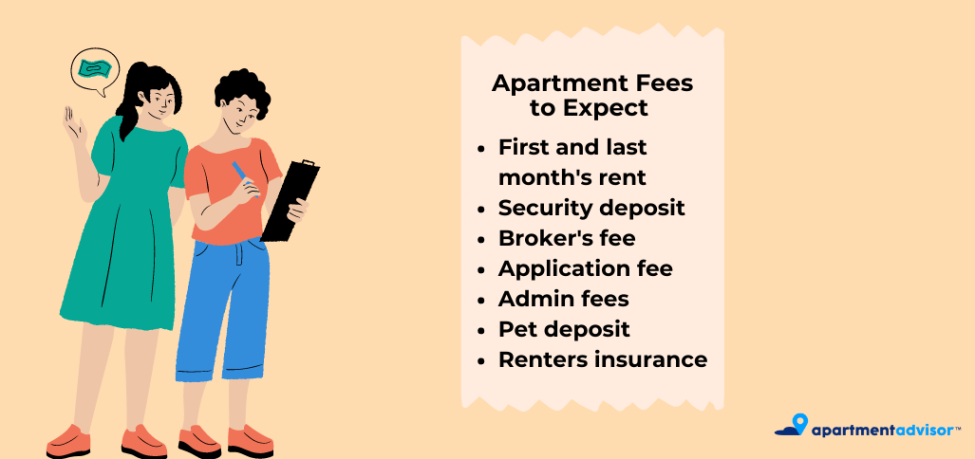
Moving is expensive — and it’s not just because of all the furniture you’ll have to buy. When you rent an apartment, you’ll most likely need to pay your landlord your first and last month’s rent, and a security deposit equal to one month’s rent. That means, at the signing of your lease, you’ll need three times the cost of one month’s rent. If you worked with a broker, they will also require you to pay a fee equal to one month’s rent — meaning you’ll actually have four times the monthly rent due at your lease signing. (The security deposit will be placed in a bank account and returned to you at the end of your lease, minus any fees required for repairs on property damage.)
Not to mention, there are other apartment fees that can sneak up on you. As we mentioned earlier, some landlords will require you to pay an application fee, while others will tack on an “admin fee” as well, which is supposed to cover the time and expense associated with tenant screening and vetting, such as answering questions, confirming employment, checking references, and executing the rental agreement. Amenities like parking may also come with a price tag. If you are moving in with a pet, you may need to pay a pet deposit as well as a monthly pet rent in some buildings.
Some landlords may even require you to purchase renters insurance for the duration of your tenancy, so be aware of all fees that will be expected of you before signing your lease.
So, the ink on your lease has dried, and you are nearly across the finish line. Congratulations! Now it’s time to start planning your move. There’s more to the process than packing. Aside from making sure you have enough moving boxes, bubble wrap, and packing tape, there are many other details you must attend to — that’s where a moving checklist comes in handy.
Ideally, you’ll have a few months to get organized. We recommend that you start packing non-essential items (like off-season clothing, extra linens, and decorative items) about two months out from your move. If you will be using professional movers to help you get settled into your new space, this is also a good time to start researching companies.
As your move-in date gets closer, you can start packing more and more items you aren’t planning on using until you relocate. Aim to have almost everything boxed up about two weeks before your move-in date. And trust us, label your boxes. It’ll make unpacking much smoother.
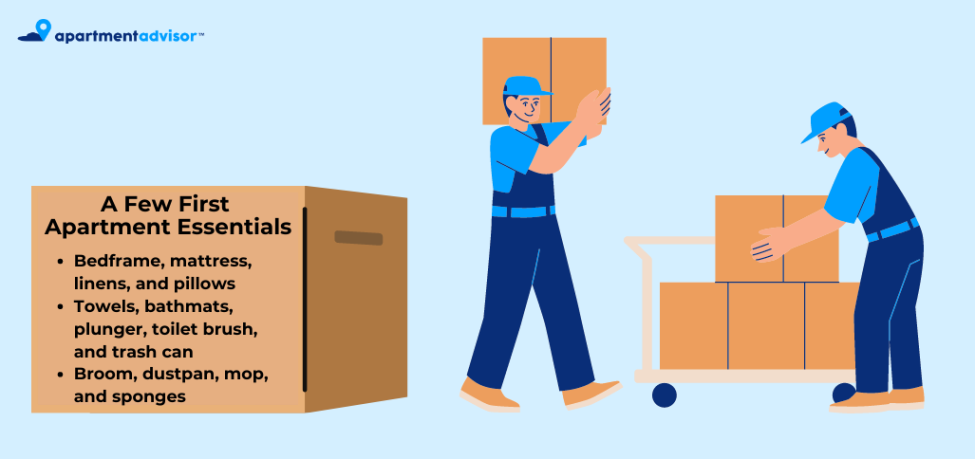
No matter how much you pack, it’ll be hard to avoid a trip to the grocery store or your local Target once you finally get into your new place. We’ve created a practical, printable, interactive checklist of essentials for your first apartment.
When you first move in, focus on the items you’ll need right away, like:
- Lighting if your apartment doesn’t have overhead lights
- A bed and linens
- Bathroom essentials like towels, bathmats, a plunger and toilet brush, a trash can, and toothpaste
- Cooking essentials like a basic pot and pan set, a set of dishware and silverware, kitchen knives, sponges, and dish soap
- Cleaning essentials like a broom, dustpan, mop, and all-purpose countertop cleaner
The Bottom Line
Moving out seems daunting, but it’s an important first step to adulthood. As long as you have done your research, you’ll be prepared for your first apartment search — even if there are a few extra steps for student tenants, like finding a guarantor. Just remember to stay organized, and to keep budget and timing in mind.
Top cities
Atlanta Apartments
1,997 apartments starting at $640/month
Austin Apartments
4,754 apartments starting at $625/month
Baltimore Apartments
1,222 apartments starting at $600/month
Boston Apartments
3,491 apartments starting at $425/month
Charlotte Apartments
2,970 apartments starting at $450/month
Chicago Apartments
4,431 apartments starting at $550/month
Dallas Apartments
5,489 apartments starting at $587/month
Fort Worth Apartments
2,231 apartments starting at $555/month
Houston Apartments
5,220 apartments starting at $495/month
Las Vegas Apartments
1,048 apartments starting at $695/month
Los Angeles Apartments
11,451 apartments starting at $625/month
Miami Apartments
527 apartments starting at $995/month
Milwaukee Apartments
881 apartments starting at $465/month
New York Apartments
4,568 apartments starting at $800/month
Oakland Apartments
647 apartments starting at $995/month
Orlando Apartments
838 apartments starting at $800/month
Philadelphia Apartments
3,084 apartments starting at $500/month
Phoenix Apartments
4,271 apartments starting at $500/month
Pittsburgh Apartments
937 apartments starting at $695/month
Portland Apartments
2,551 apartments starting at $599/month
Raleigh Apartments
1,356 apartments starting at $625/month
San Antonio Apartments
3,887 apartments starting at $468/month
San Diego Apartments
2,920 apartments starting at $650/month
San Francisco Apartments
573 apartments starting at $675/month
San Jose Apartments
449 apartments starting at $1,300/month
Seattle Apartments
3,627 apartments starting at $450/month
Tampa Apartments
1,140 apartments starting at $800/month
Washington DC Apartments
2,917 apartments starting at $936/month


